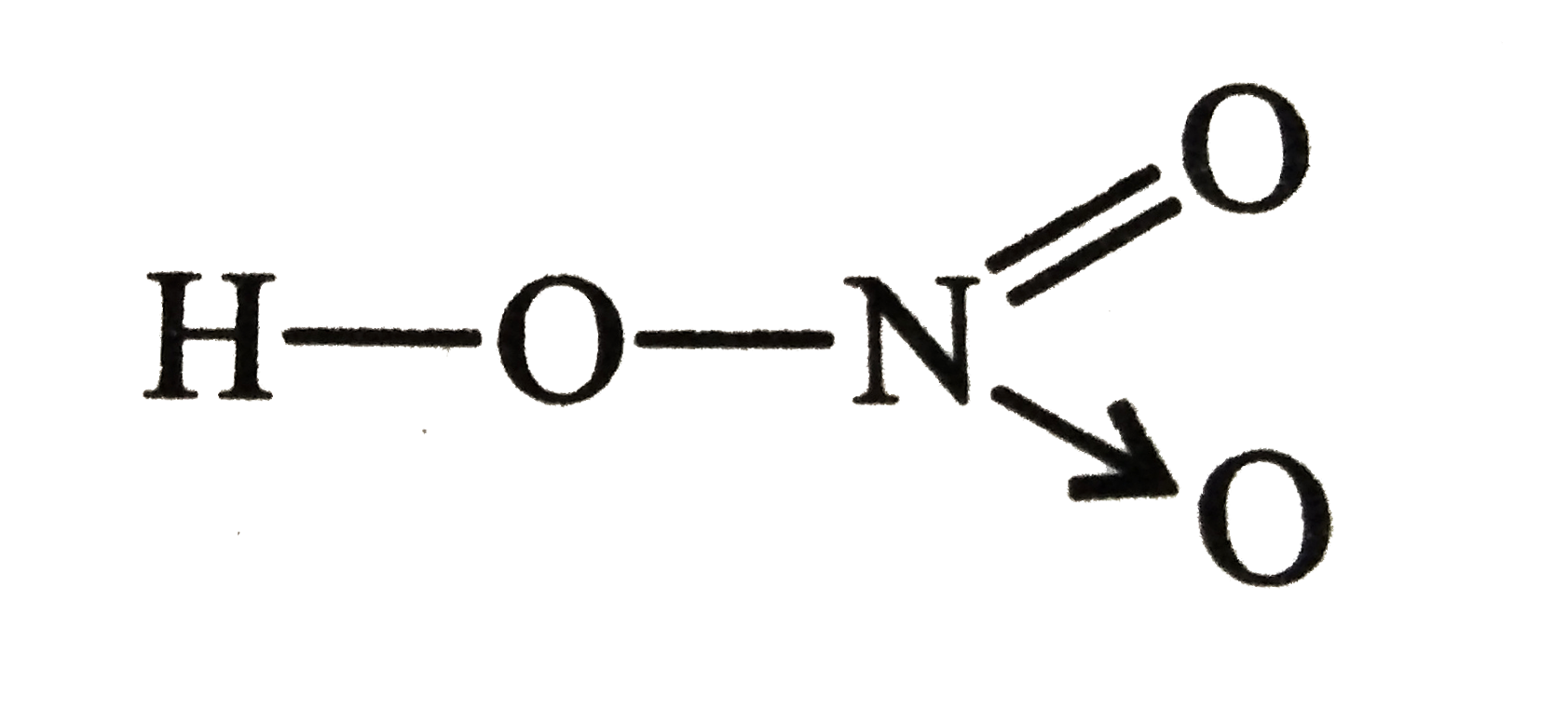Determine the oxidation number of following underline elements:
a. HCN––
b. HN––C
c. HN––O3
d. KO––2
e. Fe3––––O4
f. KI3––
g. N3–––H
h. Fe–––(CO)5
i. Fe0.94–––––––O
j. N––H2NH2
k. Fe–––SO4(NH4)2SO46H2O
l. N––OCI
m. NOCl–––O4
n. Na2[Fe–––(CN)5NO]
o. [Fe–––(NO)(H2O)5]SO4
p. Na2S4––––O6
q. (CH3)2SO––––
r. NaS2–––O3
s. CaOCl2––––.
a. HCN: The evaluation cannot be made directly in some cases, e.g., HCN, by using rules proposed earlier as we have no rule for the evaluation of oxidation number of both N and C. In all such cases, evaluation of oxidation number should be made using indirect concept or using fundamentals by which following rules have been formed:
i. Each covalently bond contribures one unit of oxidation number.
ii. Covalently bonded atoms with less electronegativity acquire positive oxidation number whereas other atoms with more electronegativity acquire negative oxidation number.
iii.In case of coordinate bond, give +2 value for oxidation number to the atom from which coordinate bond is directed to a more electronegative atom.
If coordinate bond is directed from a more electronegative to a less electronegative atom, then neglect the contribution of coordinate bond of both atoms in which coordinate bond exists.
Thus, H−C≡N
Three bond N atom implies more electronegative
1+a+3(−1)=0
Oxidation number of N=3(−1)=−3
Oxidation number of C,a=+2
b. HN––C:H−C≡N
Oxidation number of H=+1
Oxidation number of N
[=-2+ (-1)+ 0]= -3[For covalentbond with C][For covalentbond with H[No contributionfor coordinatebond]
According to fundamental concept =−3
∴1+(−3)+a=0⇒a=+2
c. N––O3 : By rules , 1+a+3(−2)=0⇒a=+5
By fundamental approach
+N3
Oxidation number of H=+1
Oxidation number of N
=+1+ (+2)+ ( +2)=+5[ covalentbond with O][Two covalentbond with O,N being lesselectronegativethan O][coordinatebond]
d. KO2–––: A superoxide of K
Oxidation number of K=+1
Oxidation number of O=a
1+2(a)=0 and a=−1/2
e. Fe3––––O4: 3(a)+4(−2)=0⇒a=+8/3
Fe3O4 is a mixed oxide of FeO.Fe2O3.
Therefore, Fe has two oxidation numbers +2 and +3, respectively. However, factually speaking, oxidation number in Fe3O4 is an average of two values, i.e., +2 and +3.
Therefore, average oxidation number =+2+(×3)3=+83
I3––: 1+3(a)=a⇒a=−1/3
Since KI3 is KI+I2, therefore, I has two oxidation numbers −1 and 0, respectively.
However, oxidation number of I and KI3 is an average of two values −1 and 0.
Therefore, average oxidation number
=−1+2(0)3=−13
g. N3–––H: 3(a)+1=0⇒a=−1/3
h. Fe–––(CO)5: Sum of oxidation number of CO=0
∴a+5(0)=0⇒a=0
i. Fe0.94–––––––O: 0.94(a)+(−2)=0⇒a=200/94
j. N––H2N––H2: Both N have same nature, therefore each n has oxidation number −2.
Fe–––SO4(NH4)2SO4.6H2O:
Oxidation number of Fe=a
Sum of oxidation number for (NH4)2SO4=0
Sum of oxidation number of H2O=0
Sum of oxidation number of SO2−4=−2
∴a+(−2)+0+6(0)=0⇒a=+2
l. N––OCl: Cl−N=O or use NO⊕ClӨ
Oxidation number of N=−+1 (for covalent bonds with Cl)
Oxidation number of N=+2 (for two covalent bonds with O)
Therefore, oxidation number of N in NOCl=+3
m. NOCl–––O4: The compound may be written as NO+ClOӨ4 for ClOӨ4.
For ClOӨ4, let the oxidation number of Cl=a.
∴a+4(−2)=−1⇒a=+7
n. Na2[Fe–––(CN)5NO] : NO in ion complex has H⊕ nature
∴2×1+[a+5(−1)+(+1)]=0
∴a=+2
o. [Fe–––(NO)(H2O)5]SO4:
a+1+5×0+(−2)=0
⇒a=+1
p. Na2S4O6: 2(+1)+4a+6(−2)=0
∴a=+5/2
Here also, this value is the average oxidation number of S. The structure of Na2S4O6 is
Na−O−O↑S↓O−S−S−O↑S↓O−O−Na
Thus, oxidation nuber of each S atom forming coordiante bond is +5, whereas oxidation number of each S atom involved in pure covalent bonding is zero. Therefore, average oxidation number
=+5+5+0+04=+52
q. Dimethyl sulphoxide or (CH3)2S––O:
Oxidation number of CH3=+1
Oxidation number of O=−2
∴2(+1)+a+(−2)=0⇒a=0
r. Na2S2–––O3: 2×1+2×a+3(−2)=0⇒a=+2
Here too, it is the average oxidation number.
The sturcture of Na2S2O3 is
Na−S−O↑S↓O−O−Na
The oxidation number of S involved in coordinate bond, i.e., donor S atom, is +5. The oxidation number of other S atom is −1.
s. CaCl2––––: In bleaching powder, two Cl atoms are as Ca(Cl)Cl, i.e., one as ClӨ having oxidation number −1 and other as OClӨ having oxidation number +1.

Topper's Solved these Questions
- BOOK - CENGAGE CHEMISTRYCHAPTER - REDOX REACTIONSEXERCISE - Ex 2.110videos
REDOX REACTIONS
- BOOK - CENGAGE CHEMISTRYCHAPTER - REDOX REACTIONSEXERCISE - Ex 2.218videos
REDOX REACTIONS
- BOOK - CENGAGE CHEMISTRYCHAPTER - PURIFICATION OF ORGANIC COMPOUNDS AND QUALITATIVE AND QUANTITATIVE ANALYSISEXERCISE - Assertion Reasoning Type5videos
PURIFICATION OF ORGANIC COMPOUNDS AND QUALITATIVE AND QUANTITATIVE ANALYSIS
- BOOK - CENGAGE CHEMISTRYCHAPTER - S-BLOCK GROUP 1 - ALKALI METALSEXERCISE - Archives Subjective8videos
S-BLOCK GROUP 1 - ALKALI METALS
Similar Questions
Calculate the oxidation number of the underlined element in the following ions.
S––2O2−3View SolutionCalculate the oxidation number of the underlined element in the following molecules.
H2S––O4View SolutionNa2CO3, Fe2(SO4)3, FeSO4.7H2O
View SolutionDetermine the oxidation number of the underlined elements in the following species.
Si–––H4,B––H3,B––F3,Br–––O−4andHP––O2−4View SolutionAssign oxidation number to the underlined elements in each case
(N––2H5)2SO4View SolutionCalculate the oxidation number of the underlined element in the following molecules.
Na2S2–––O3View SolutionCalculate the oxidation number of the underlined element in the following molecules.
Na3P––O4View SolutionCalculate the oxidation number of the underlined element in the following molecules.
Na2S4–––O6View SolutionCalculate the oxidation number of underlined elements in following compounds:
(i) CaO––2 (ii) H2S––2O7 (iii) K2Mn––––O4 (iv) KI–3View SolutionDetemine the oxidation no. of the folliwing elements given in bold letters:
(a) KmnO4, (b) H2SO5
(c) H2S2O8m (d) NH4NO3
(e) K4Fe(CN)6, (f) OsO4
(g) HCN, (h) HNC
(i) HNO3, (j) KO2
(k) Fe3O4, (l) KI3
(m) N3H, (n) Fe(CO)5
(o) Fe0.94O, (p) NH2NH2
(q) FeSO.(4).(NH4)2SO46H2O
(r) Na2[Fe(CN)5NO], (u) [Fe(NO)(H2O)5]SO4
(v) Na2S4O6
(v) Na2S2O3
(w) Dimethyl sulphoxide or (CH3)2SO
(x) Na2S2O3, (y) CrO5 or CrO(O2)2
(z) CaOCl2View Solution

